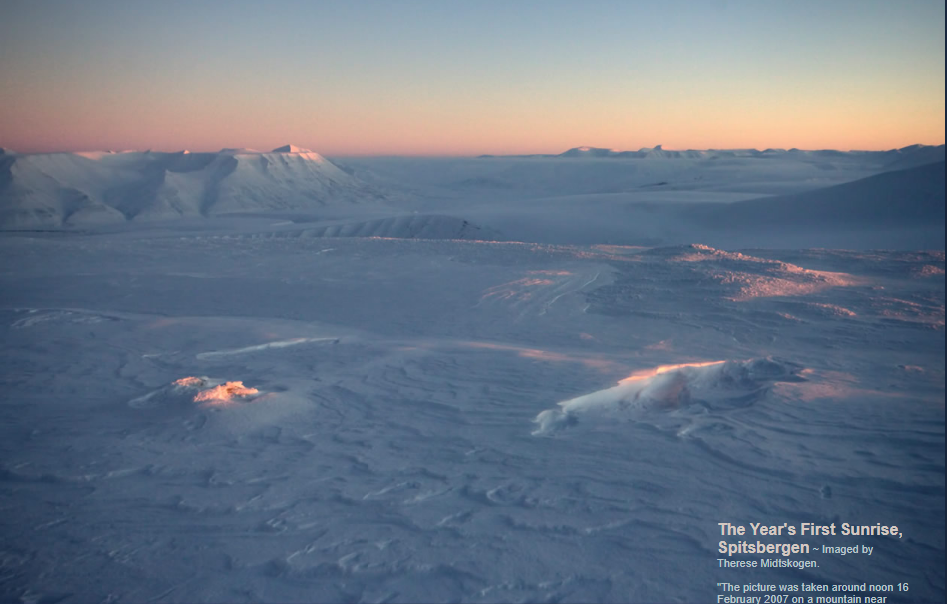OPOD - Year's First Sunrise, Svalbard
The Year's First Sunrise, Svalbard: A Spectacular Phenomenon
Svalbard, an archipelago located at a latitude of approximately 78.5°N, experiences an extraordinary event known as the year's first sunrise. After enduring four months of winter darkness, the sun finally emerges above the horizon, marking the end of the long polar night. This captivating spectacle is visible only from the mountain peaks, where the sun skims the edge of the horizon for a fleeting two-hour period. On February 16, 2007, Therese Midtskogen captured this breathtaking moment from a mountain near Longyearbyen, the largest settlement on Svalbard.
As we examine Midtskogen's photograph, we are greeted by an array of stunning atmospheric optical phenomena. To the extreme left of the image, we can observe the last remnants of Earth's shadow, a dark band that contrasts with the rosy-hued "Belt of Venus" or anti-twilight arch. The blue-purple snow covering the landscape is illuminated solely by the soft light scattered by the sky.
One remarkable feature depicted in the photograph is the phenomenon known as "Alpenglow." Typically associated with the warm reddish glow observed on mountain peaks after sunset or before sunrise, Alpenglow can also refer to the sunlight gradually reaching the mountaintops during the year's first sunrise. This natural phenomenon creates a captivating display of colors, as the sun's rays interact with the snow-covered peaks.
The image captured by Midtskogen showcases the ethereal beauty of Svalbard's landscape during this unique time. To fully appreciate the grandeur of the year's first sunrise, it is essential to consider the atmospheric conditions and physical processes at play. Here are some fascinating aspects to delve into:
-
Polar Night: Svalbard experiences a period of continuous darkness during winter due to its high latitude. The absence of sunlight creates an otherworldly environment that envelops the archipelago in an eerie stillness.
-
The Return of Sunlight: The year's first sunrise symbolizes the return of sunlight to Svalbard after months of darkness. This event marks a significant milestone for the residents, who eagerly anticipate the gradual lengthening of daylight hours.
-
Limited Visibility: During the year's first sunrise, the sun remains close to the horizon, resulting in limited visibility. Only those positioned atop the mountain peaks can witness this extraordinary sight, making it a cherished experience for those fortunate enough to be present.
-
Atmospheric Optics: The photograph captures various atmospheric optical phenomena, such as Earth's shadow and the Belt of Venus. These phenomena occur due to the scattering of sunlight by particles in the atmosphere, resulting in striking color gradients and captivating visual effects.
-
Alpenglow: The term "Alpenglow" typically refers to the warm reddish glow observed on mountain peaks during twilight. However, during the year's first sunrise, Alpenglow also encompasses the gradual illumination of mountaintops as sunlight reaches them for the first time in months.
-
Sky Lighting: The blue-purple hue of the snow visible in the image is a result of "sky lighting." During the polar night, when direct sunlight is absent, the snow is illuminated by the scattered light from the sky. This phenomenon contributes to the overall enchanting ambiance of the scene.
Witnessing the year's first sunrise in Svalbard is a truly magical experience. The combination of breathtaking natural landscapes, atmospheric optical phenomena, and the symbolic return of sunlight creates a spectacle that leaves a lasting impression on all who have the privilege to behold it. Therese Midtskogen's photograph serves as a visual testament to the extraordinary beauty and wonder of this annual phenomenon.
Please note that this article has been automatically converted from the old site and may not appear exactly as intended. You can find the original article here.

The Year's First Sunrise,
Spitsbergen ~ Imaged by Therese Midtskogen.
"The picture was taken around noon 16 February 2007 on a mountain near Longyearbyen .Latitude ~78.5°N Svalbard Archipelago. at an altitude of about 800 m.
This is the day when the sun rises above the horizon for the first time in the year and breaks the four month winter darkness. The sun is only visible from the mountain tops. It just skims the horizon and the sight lasts about two hours."
Image©Therese Midtskogen
At extreme left is the last vestige of the Earth's shadow and the rosy hued 'Belt of Venus' or anti-twilight arch.
The blue-purple snow is lit only by sky light.
Sunlight just reaching mountain peaks is often called 'Alpenglow'. However, this term is reserved by some to the rosy hue of a mountain top after sunset or before sunrise when it is illuminated purely by bright twilight. Both events are beautiful.
Note: this article has been automatically converted from the old site and may not appear as intended. You can find the original article here.
Reference Atmospheric Optics
If you use any of the definitions, information, or data presented on Atmospheric Optics, please copy the link or reference below to properly credit us as the reference source. Thank you!
-
<a href="https://atoptics.co.uk/blog/opod-years-first-sunrise-svalbard/">OPOD - Year's First Sunrise, Svalbard</a>
-
"OPOD - Year's First Sunrise, Svalbard". Atmospheric Optics. Accessed on April 18, 2024. https://atoptics.co.uk/blog/opod-years-first-sunrise-svalbard/.
-
"OPOD - Year's First Sunrise, Svalbard". Atmospheric Optics, https://atoptics.co.uk/blog/opod-years-first-sunrise-svalbard/. Accessed 18 April, 2024
-
OPOD - Year's First Sunrise, Svalbard. Atmospheric Optics. Retrieved from https://atoptics.co.uk/blog/opod-years-first-sunrise-svalbard/.